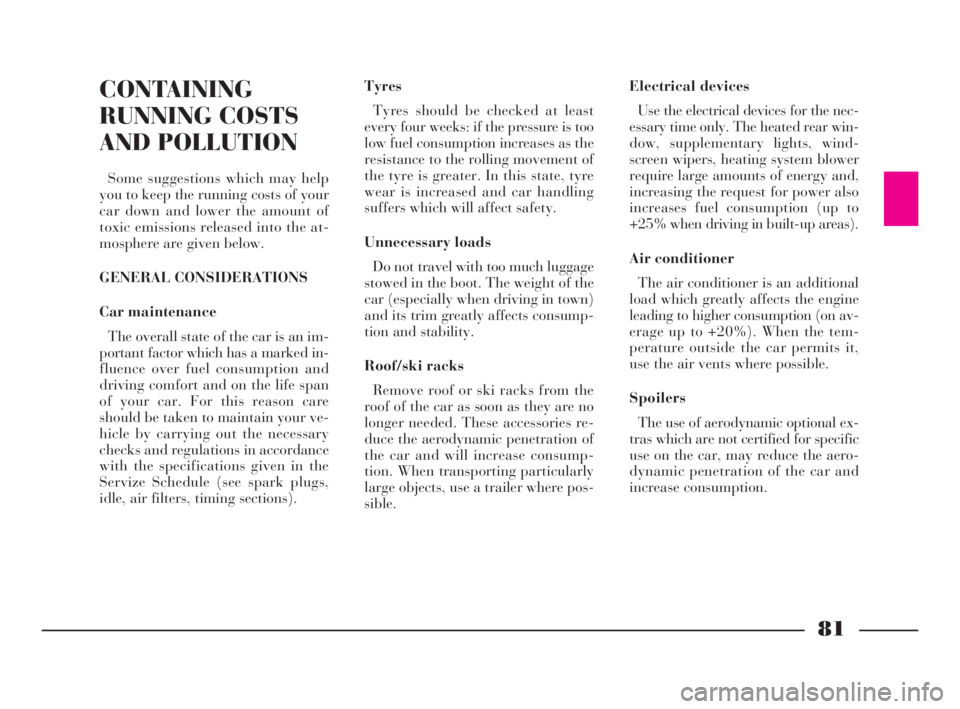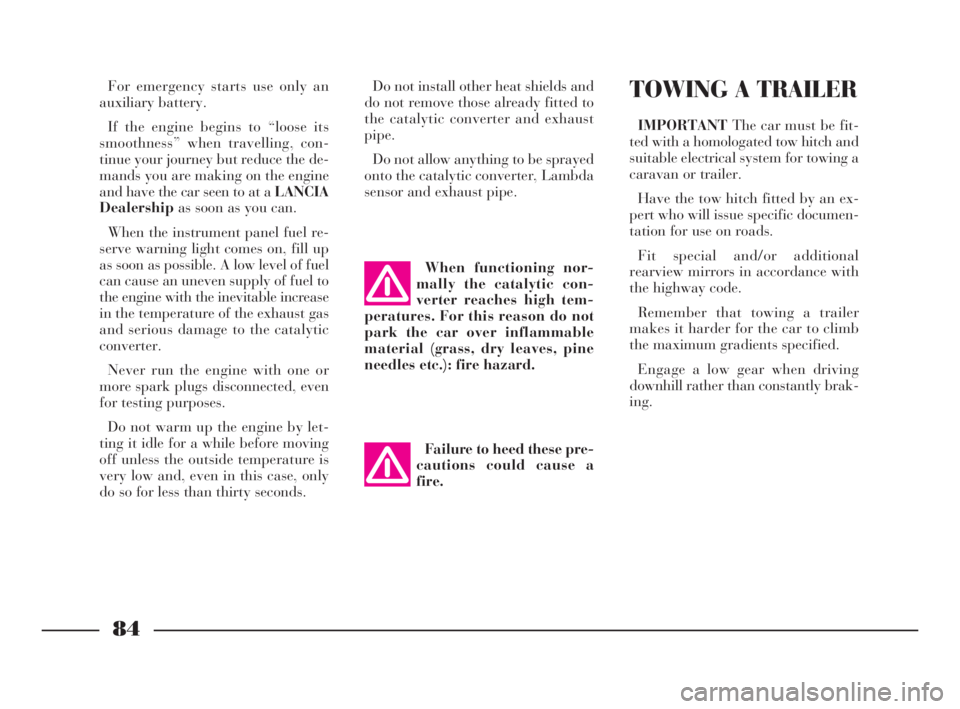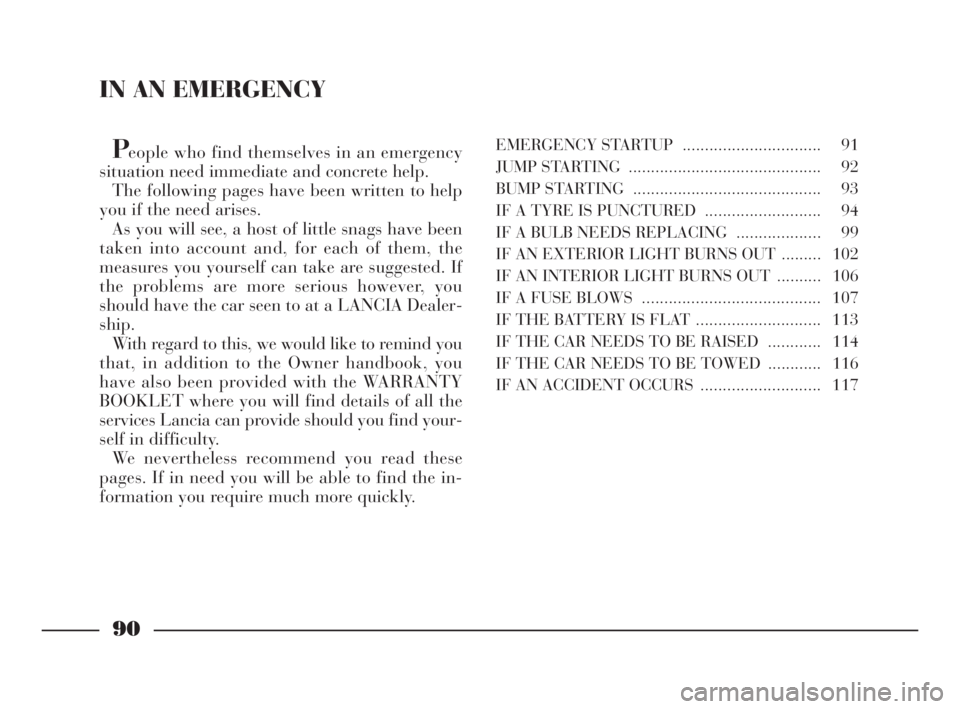tow Lancia Ypsilon 2003 Owner handbook (in English)
[x] Cancel search | Manufacturer: LANCIA, Model Year: 2003, Model line: Ypsilon, Model: Lancia Ypsilon 2003Pages: 191, PDF Size: 2.45 MB
Page 84 of 191

81
G
CONTAINING
RUNNING COSTS
AND POLLUTION
Some suggestions which may help
you to keep the running costs of your
car down and lower the amount of
toxic emissions released into the at-
mosphere are given below.
GENERAL CONSIDERATIONS
Car maintenance
The overall state of the car is an im-
portant factor which has a marked in-
fluence over fuel consumption and
driving comfort and on the life span
of your car. For this reason care
should be taken to maintain your ve-
hicle by carrying out the necessary
checks and regulations in accordance
with the specifications given in the
Servize Schedule (see spark plugs,
idle, air filters, timing sections).Tyres
Tyres should be checked at least
every four weeks: if the pressure is too
low fuel consumption increases as the
resistance to the rolling movement of
the tyre is greater. In this state, tyre
wear is increased and car handling
suffers which will affect safety.
Unnecessary loads
Do not travel with too much luggage
stowed in the boot. The weight of the
car (especially when driving in town)
and its trim greatly affects consump-
tion and stability.
Roof/ski racks
Remove roof or ski racks from the
roof of the car as soon as they are no
longer needed. These accessories re-
duce the aerodynamic penetration of
the car and will increase consump-
tion. When transporting particularly
large objects, use a trailer where pos-
sible.Electrical devices
Use the electrical devices for the nec-
essary time only. The heated rear win-
dow, supplementary lights, wind-
screen wipers, heating system blower
require large amounts of energy and,
increasing the request for power also
increases fuel consumption (up to
+25% when driving in built-up areas).
Air conditioner
The air conditioner is an additional
load which greatly affects the engine
leading to higher consumption (on av-
erage up to +20%). When the tem-
perature outside the car permits it,
use the air vents where possible.
Spoilers
The use of aerodynamic optional ex-
tras which are not certified for specific
use on the car, may reduce the aero-
dynamic penetration of the car and
increase consumption.
4C068-089 ING 11-03-2008 11:59 Pagina 81
Page 86 of 191

83
G
Traffic and road conditions
Heavy traffic and higher consump-
tion are synonymous; for example,
when driving slowly with frequent use
of the lower gears or in large towns
where there are numerous traffic
lights.
Winding roads, mountain roads and
bumpy roads also have a negative ef-
fect on consumption.
Enforced halts
During prolonged hold-ups (traffic
lights, level crossings) the engine
should be switched off.LOOKING AFTER EMISSION
CONTROL DEVICES
The correct use of pollution control
devices not only ensures respect for
the environment but also has an effect
on the car’s performance. Keeping
these devices in good condition is
therefore a fundamental rule for dri-
ving that is easy on your pocket and
on the environment too.
The first step to take is to follow the
Service Schedule to the letter.
Use only unleaded petrol.
If you have trouble starting, do not
keep turning the ignition key for long
periods. Be especially careful to avoid
bump starting the car by pushing,
towing or rolling down hill: these are
all manoeuvres that can damage the
catalytic exhaust.CHEAP RUNNING
THAT RESPECTS
THE ENVIRONMENT
Environmental protection has been
one of the guiding principles in the
production of the Lancia Y. It is no ac-
cident that its pollution control equip-
ment is much more effective than that
required by current legislation.
Nonetheless, the environment can-
not get by without a concerted effort
from everyone.
By following a few simple rules you
can avoid harming the environment
and often cut down fuel consumption
at the same time.
On this subject, a few useful tips
have been given below to supplement
those marked by symbol #at various
points of the handbook.
You are asked to read both the for-
mer and latter carefully.
4C068-089 ING 11-03-2008 11:59 Pagina 83
Page 87 of 191

84
G
For emergency starts use only an
auxiliary battery.
If the engine begins to “loose its
smoothness” when travelling, con-
tinue your journey but reduce the de-
mands you are making on the engine
and have the car seen to at a LANCIA
Dealershipas soon as you can.
When the instrument panel fuel re-
serve warning light comes on, fill up
as soon as possible. A low level of fuel
can cause an uneven supply of fuel to
the engine with the inevitable increase
in the temperature of the exhaust gas
and serious damage to the catalytic
converter.
Never run the engine with one or
more spark plugs disconnected, even
for testing purposes.
Do not warm up the engine by let-
ting it idle for a while before moving
off unless the outside temperature is
very low and, even in this case, only
do so for less than thirty seconds.When functioning nor-
mally the catalytic con-
verter reaches high tem-
peratures. For this reason do not
park the car over inflammable
material (grass, dry leaves, pine
needles etc.): fire hazard.
Failure to heed these pre-
cautions could cause a
fire.
Do not install other heat shields and
do not remove those already fitted to
the catalytic converter and exhaust
pipe.
Do not allow anything to be sprayed
onto the catalytic converter, Lambda
sensor and exhaust pipe.TOWING A TRAILER
IMPORTANTThe car must be fit-
ted with a homologated tow hitch and
suitable electrical system for towing a
caravan or trailer.
Have the tow hitch fitted by an ex-
pert who will issue specific documen-
tation for use on roads.
Fit special and/or additional
rearview mirrors in accordance with
the highway code.
Remember that towing a trailer
makes it harder for the car to climb
the maximum gradients specified.
Engage a low gear when driving
downhill rather than constantly brak-
ing.
4C068-089 ING 11-03-2008 11:59 Pagina 84
Page 88 of 191

85
G
The ABS system with
which the car may be fitted
does not control the brak-
ing system of a trailer. Special care
must therefore be taken on slip-
pery surfaces.
Under no circumstances
modify the car’s braking
system for trailer braking
control. The trailer’s braking sys-
tem must be completely indepen-
dent of the car’s hydraulic system.The weight the trailer exerts on the
car’s tow hitch coupling reduces the
car’s carrying capacity by the same
amount.
In order to be sure you are not ex-
ceeding the maximum towing weight
(given on the car’s registration pa-
pers), you have to take into account
the trailer’s weight fully laden in-
cluding the accessories and personal
luggage.
Do not exceed the speed limits for
towing a trailer in the country you are
driving in. In any case, do not exceed
the top speed of 100 km/h.SNOW CHAINS
The use of snow chains is regulated
by the legislation in force in the coun-
try the car is driven in.
The chains may only be applied to
the drive wheel tyres (front wheels).
Use only low profile chains (maxi-
mum height off the tyre: 12 mm).
Check the tautness of the chains af-
ter driving some twenty to thirty me-
tres.
IMPORTANTAs the spare wheel is
small (space-saver), it is not possible
to fit snow chains to it. If a front tyre
is punctured, first exchange a rear
wheel with the spare tyre and then
change the flat tyre with the rear wheel
thus removed. This way there will be
two ordinary wheels at the front and
the snow chains can be fitted.
Remember that the wheels should
always be exchanged on the same side
of the vehicle; never change wheels
over from one side of the car to the
other.
4C068-089 ING 11-03-2008 11:59 Pagina 85
Page 93 of 191

IN AN EMERGENCY
People who find themselves in an emergency
situation need immediate and concrete help.
The following pages have been written to help
you if the need arises.
As you will see, a host of little snags have been
taken into account and, for each of them, the
measures you yourself can take are suggested. If
the problems are more serious however, you
should have the car seen to at a LANCIA Dealer-
ship.
With regard to this, we would like to remind you
that, in addition to the Owner handbook, you
have also been provided with the WARRANTY
BOOKLET where you will find details of all the
services Lancia can provide should you find your-
self in difficulty.
We nevertheless recommend you read these
pages. If in need you will be able to find the in-
formation you require much more quickly.EMERGENCY STARTUP ............................... 91
JUMP STARTING ........................................... 92
BUMP STARTING .......................................... 93
IF A TYRE IS PUNCTURED.......................... 94
IF A BULB NEEDS REPLACING................... 99
IF AN EXTERIOR LIGHT BURNS OUT ......... 102
IF AN INTERIOR LIGHT BURNS OUT .......... 106
IF A FUSE BLOWS........................................ 107
IF THE BATTERY IS FLAT ............................ 113
IF THE CAR NEEDS TO BE RAISED ............ 114
IF THE CAR NEEDS TO BE TOWED ............ 116
IF AN ACCIDENT OCCURS........................... 117
90
G
4C090-119 ING 11-03-2008 12:00 Pagina 90
Page 97 of 191

94
G
into the catalytic exhaust
pipe and damage it beyond
repair.
BUMP
STARTING
Bump starting by pushing, towing
or rolling downhill must be
avoided at all costs. This way of
starting could cause a rush of fuelRemember that as long as
the engine is not running,
the brake booster and
power steering do not work. You
therefore have to use considerably
more effort on both the brake
pedal and the steering wheel.
IF A TYRE
IS
PUNCTURED
GENERAL INDICATIONS
The following precautions must be
observed when changing a wheel and
using the jack and the space-saver
spare wheel.
4C090-119 ING 11-03-2008 12:00 Pagina 94
Page 100 of 191

97
G
1. STOP THE CAR
– Stop the car so it is not a danger
for on-coming traffic and in such a
position that the tyre can be changed
in safety. The ground must be flat and
adequately firm. During the night,
chose a lit area, if possible.
– Turn engine off and engage the
handbrake.
– Engage first or reverse gear.
– Signal that the car is stopped ac-
cording to traffic regulations: hazard
lights, warning triangle, etc.
Any passengers must leave the car
and watch out for traffic while the
tyre is being changed.
If the ground is sloping or bumpy,
place wedges or other suitable mate-
rial for stopping the car under the
wheels.2. TAKE OUT THE TOOLS,
JACK AND SPARE WHEEL
(space-saver wheel)
They are in the boot.
– Lift the carpeting.
– Unscrew the fastener A (fig. 2)
and take out the tool holder.
The tool holder contains:
B- vehicle tow ring;
C- jack handle;
D- wheel bolt wrench;
E- screwdriver;F- extension for screwing wheel
bolts and inflation valve cap;
G- jack.
fig. 4
P4C00402
fig. 5
P4C00045
4C090-119 ING 11-03-2008 12:00 Pagina 97
Page 101 of 191

98
G
– Take out the tools and remove the
space-saver spare wheel.
IMPORTANTThe indications
which follow must be complied with
to ensure that the jack and the spare
wheel are used correctly.
It must be remembered that:
– the jack weighs 1.85 kg;
– the jack does not require adjust-
ments;
– the jack cannot be repaired. If it
breaks, it must be changed with an-
other new jack;
– only the jack handle described in
this chapter can be fitted onto the
jack.
3. CHANGING THE WHEEL1)Remove the wheel cup with a
screwdriver (LS versions).
2)Loosen the wheel bolts of the
wheel to be changed by about 1 turn.
3)If the car is fitted with alloy rims,
shake the car to facilitate removing
the rim from the wheel hub.
4)Turn the jack handle Cso that
the jack opens partially.
5)Place the jack at the point marked
by a notch H (fig. 3)near the wheel to
be changed at approximately 10 cm
towards the centre of the car (fig. 3).6)Turn the handle Cto open the
jack until the jack groove is correctly
inserted in the sidemember ribbing.
7)Warn any other people present
that the car is going to be lifted. Other
people must stay clear and not touch
the car until it is back on the ground.
8)Turn jack handle and lift the ve-
hicle until the tyre is a few centime-
tres above the ground.
The jack handle must turn freely,
without touching the ground to avoid
scraping your hand.
Do not touch moving parts of the
jack (screws and joints) as they can
cause injuries. If you dirty your hands
with grease, clean them carefully.
9)Undo the 4 bolts completely and
remove the wheel cover (Nversion)
and wheel.
fig. 6
P4C00161
fig. 7
P4C00403
4C090-119 ING 11-03-2008 12:00 Pagina 98
Page 119 of 191

116
fG
IF THE CAR NEEDS
TO BE TOWED
The tow ring is supplied as standard
with the car.
How to attach the tow ring to the
car:
1)Take the tow ring out of its sup-
port, located under the boot carpeting.
2)Remove the flap in the bumper,
using a screwdriver to pry it off.
3)Screw ring A (fig. 42)onto the
threaded pin B (fig. 43)orC (fig. 44)
which can be seen when the cover is
removed.When towing the car, you
must adhere to the specific
traffic regulations regard-
ing the tow hitch and how to tow
on the road.
B- front anchorage point (fig. 43).
C- rear anchorage point (fig. 44).
fig. 42
P4C00135
fig. 43
P4C00412
fig. 44
P4C00003
4C090-119 ING 13-03-2008 12:51 Pagina 116
Page 120 of 191

117
fG
While the car is being
towed with the engine off,
remember that the brake
pedal and steering will require
more effort as you no longer have
the benefit of the brake booster
and power steering. Do not use
flexible cables to tow. Avoid jerk-
ing. Whilst towing, ensure that the
coupling to the car does not dam-
age the surrounding components.Do not extract the igni-
tion key during towing;
leave it at MAR, to prevent
the steering lock engaging and,
provided the electrical system is
not damaged, keep the brake lights
and direction indicators working.
When the ignition key is re-
moved, the steering lock will cut in
thus preventing the steering wheel
from being turned.IF AN ACCIDENT
OCCURS
– It is important to keep calm.
– If you are not directly involved,
stop at least ten metres away from the
accident.
– If you are on a motorway do not
obstruct the emergency lane with your
car.
– Turn off the engine and turn on
the hazard lights.
– At night, illuminate the scene of
the accident with your headlights.
– Act carefully, you must not risk
being run over.
– Mark the accident by putting the
red triangle at the regulatory distance
from the car where it can be clearly
seen.
– If the doors are jammed, do not try
to leave the car by breaking the glass
of the windscreen as the glass is strat-
ified. Side windows and the rear win-
dow can be broken more easily.
4C090-119 ING 13-03-2008 12:51 Pagina 117